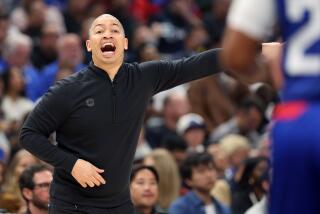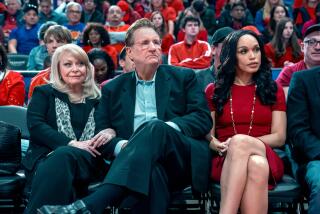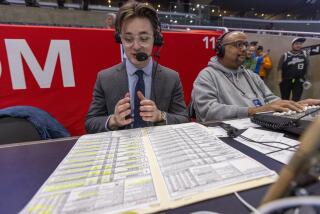A Witness to a Long-Suffering Team : THE CLIPPERS’ RALPH LAWLER ENDURES--AND EVEN THRIVES
Ralph Lawler would have every reason to complain about his job.
As the radio and television announcer for the Clippers for 11 of the past 12 seasons, not only has he worked for a team that has failed to make the playoffs and had only one winning season during that stretch, he has witnessed an almost unfathomable series of injuries to the team’s top players.
But the Clippers futility has not taken its toll on Lawler.
“This is the best job in the world,” Lawler said. “Professional basketball is the best sport bar none, and I’ve gotten to see every great player in the league since the 1970s.”
Lawler believes there are advantages to announcing for a hapless team.
“A broadcast is a lot more challenging when a team loses by a lot,” Lawler said. “I’ve often felt the best job I’ve done is when we’ve lost by 30 points. That’s a real challenge. A close game is simple because all the drama is there, and you don’t have to create it yourself.”
After beginning his career in Riverside, Lawler’s first sports announcing position with a pro team came with the San Diego Chargers in the early 1970s. From there, it was on to Philadelphia, where his assignments included play-by-play of the Phillies, 76ers and Flyers. He became one of only a handful of announcers to have broadcast all four major professional team sports.
Lawler joined the Clippers when they moved to San Diego in 1978. When the the team headed to Los Angeles in 1984, Lawler stayed behind in San Diego, managing a real estate office, but he rejoined the organization in 1985.
Employed by a franchise, whose only constant outside of losing is change, Lawler is the Clippers’ senior employee and has maintained his optimism throughout his tenure.
“There’s never been a period when I thought it was hopeless,” Lawler said. “Our first three years in San Diego, we were in the playoff chase until the final week, so those were exciting years.
“During the early years in Los Angeles, there were so many marquee names-Marques Johnson, Norm Nixon and Derek Smith. Going into each season, I thought this is the year it’s going to start to turn around, but a staggering amount of injuries stopped us year by year.”
This season appeared to be the year it would turn around, even after the Clippers front office lost top draft choice Danny Ferry to Italy, failed to sign starting center Benoit Benjamin until two weeks into the season, and the team lost five of its first seven games.
But everything seemingly fell into place when shooting guard Ron Harper was acquired from the Cleveland Cavaliers Nov. 16. Harper’s arrival sparked the Clippers to a near .500 record, including a 5-3 road trip, the best in the franchise’s West Coast history. When the team returned Jan. 16, Lawler sensed that game against the Charlotte Hornets was the franchise’s high point.
That night, 10,120 fans came to the Sports Arena, welcoming back the Clippers with a partial standing ovation during the introduction of the starting lineup. The media, which usually ignores the Clippers in favor of the perennial contenders across town, was also out in full force, with CBS and ESPN present to produce features on what had become the NBA’s surprise team.
“The feeling in the building was electric,” Lawler recalled. “All that hard work everyone’s put in. All those miserable nights. All those 30-point losses. All that waiting for the young players to mature that night, by God here it is. A nice home stand was lying ahead. It was a nice taking-off point. It turned out not to be.”
With 7:04 to play, Harper, who had scored a game-high 33 points, had his leg buckle upon landing while catching a pass from point guard Gary Grant. A day later, Harper’s injury was diagnosed as a torn anterior cruciate ligament with torn cartilage in his right knee. The injury put Harper out for the rest of the season, and he is expected to miss time next season as well.
Less than three weeks later, the Clippers were again hit by a season-ending injury, when Grant fractured his left ankle.
Without Harper and Grant, the Clippers have struggled again and are destined for another losing, non-playoff season. One thing the injuries have done is change the way people think about the team, Lawler said.
“I sense a sympathy that’s very prevalent,” Lawler said. “It’s a lot better than it was a couple of years ago when everyone was thinking what dummies the Clippers are. I think it will go from sympathy to real fanaticism when this club gets a chance to play as it was.”
The Clippers make three KTLA appearances this week, playing the Denver Nuggets, 6:30 p.m. Tuesday; Utah Jazz, 6:30 p.m. Wednesday; the Lakers, 7:30 p.m. Friday.
In past seasons, Lawler would shift from the radio booth to do a separate television broadcast, but this season, the Clippers’ televised games are being simulcast on KRLA radio. Lawler was quick to draw a difference between the ClippersT and LakersT simulcasts.
“The Lakers do a radio broadcast on television,” Lawler said. “We do a television broadcast on radio. If you’re going to do a simulcast, it makes sense to favor the television side because that’s where more fans are going to be tuned.
“You’re not going to drive the television audience crazy with my constant talk and description with those who are watching the game. Television is the color man’s medium, and this way, the color man has a stage where he can work. Radio is really a play-by-play man’s medium because so much description has to go into it.”
Continuing a trend first popularized by John Madden, former Oakland Raiders coach turned CBS football color commentator, the Clippers employ a former coach as a color commentator, in this case Kevin Loughery.
“As a former coach, Kevin puts a lot of insight into the game,” Lawler said. “Coaches do a good job because they have a broad understanding of the game. Most players don’t see the big picture. Kevin sees things that very few players are going to see-what’s going to happen next, what’s going to work and what’s not going to work.”
More to Read
Get our high school sports newsletter
Prep Rally is devoted to the SoCal high school sports experience, bringing you scores, stories and a behind-the-scenes look at what makes prep sports so popular.
You may occasionally receive promotional content from the Los Angeles Times.







